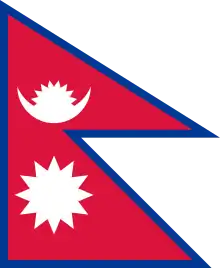Adhikari cabinet, 1994
On November 30, 1994, following the 1994 parliamentary election, the Communist Party of Nepal (Unified Marxist-Leninist) formed a minority government led by Man Mohan Adhikari.[1] Despite the Nepali Congress securing more popular votes than the Communist Party of Nepal (Unified Marxist-Leninist), the latter secured 88 seats to the former's 83. Neither party was successful in forming a coalition to hold a majority of the 205 seats. After failed coalition negotiations, Adhikari became Prime Minister of a minority government, acquiring the support of the Rastriya Prajatantra Party and the Nepal Sadbhawana Party.[2]
1994 Adhikari cabinet | |
|---|---|
 Cabinet of Nepal | |
| November 1994–September 1995 | |
| Date formed | 30 November 1994 |
| Date dissolved | 12 September 1995 |
| People and organisations | |
| Monarch | King Birendra |
| Prime Minister | Man Mohan Adhikari |
| Deputy Prime Minister | Madhav Kumar Nepal |
| Total no. of members | 15 appointments |
| Member party | CPN (Unified Marxist–Leninist) |
| Status in legislature | Minority in Pratinidhi Sabha 88 / 205 (43%) |
| Opposition party | Nepali Congress |
| Opposition leader | Girija Prasad Koirala |
| History | |
| Election(s) | 1994 general election |
| Legislature term(s) | 3rd House of Representatives |
| Predecessor | First G.P. Koirala Cabinet |
| Successor | Deuba Cabinet |
Adhikari only served as the Prime Minister of Nepal for nine months and was the first democratically elected Prime Minister from the Communist Party of Nepal (Unified Marxist-Leninist). During his time in office, then chief of the World Bank, Paul Wolfowitz rejected funding the Arun III hydro-electric project[3] Also, the Adhikari government promoted programs such as the build-your-own-village-program.[4] Prime Minister Adhikari also enhanced the relationship with Mongolia.
In June 1995, the Rastriya Prajatantra Party and the Nepal Sadbhawana Party, who helped to form a minority government supported the Nepali Congress's call for a vote of no-confidence in Adhikari's government in a special session of the House of Representatives. Adhikari attempted to dissolve parliament and call elections in an attempt to replicate the circumstances under which he assumed office in 1994. But a Supreme Court challenge led by the Congress saw this move deemed unconstitutional and the parliament was restored. The vote of no-confidence proceeded successfully. Elections in 1995 saw Adhikari's government voted out of office and made Nepali Congress's Sher Bahadur Deuba the next Prime Minister of Nepal.[5]
Ministers
| Portfolio | Minister |
|---|---|
| Cabinet ministers | |
| Prime Minister
Minister for General Administration |
Man Mohan Adhikari |
| Deputy Prime Minister
Minister of Defence Minister of Foreign Affairs |
Madhav Kumar Nepal |
| Minister for Local Development and Supplies | C.P. Mainali |
| Minister of Home Affairs | Khadga Prasad Oli |
| Minister of Finance | Bharat Mohan Adhikari |
| Minister for Agriculture, Land Reform and Management | Radha Krishna Mainali |
| Minister of Education, Culture and Social Welfare | Modanath Prasrit |
| Minister of Information and Communications | Pradip Nepal |
| Minister for Labour and Health | Padma Ratna Tuladhar |
| State ministers | |
| Minister of State for Construction and Transportation | Ashok Kumar Rai |
| Minister of State for Forest and Environment | Salim Miya Ansari |
| Minister of State for Housing and Physical Planning | Prem Singh Dhami |
| Minister of State for Law, Justice, Parliamentary Affairs and General Administration | Subash Chandra Nembang |
| Minister of State for Commerce, Tourism and Civil Aviation | Bhim Rawal |
| Minister of State for Industry and Water Resource | Hari Pandey |
References
- "Nepal Home Page". Archived from the original on 2008-10-06. Retrieved 2008-07-27.
- Whelpton, John, A History of Nepal, Cambridge University Press, 2005, pp. 192-193.
- Deutscher Bundestag. "Drucksache 13/2285 vom 08.09.1995" (in German). Retrieved 15 October 2017.
- Encyclopædia Britannica: Man Mohan Adhikari
- Whelpton, John, A History of Nepal, Cambridge University Press, 2005, pp. 193-195.
.svg.png.webp)